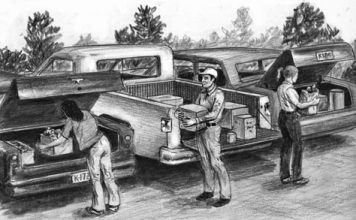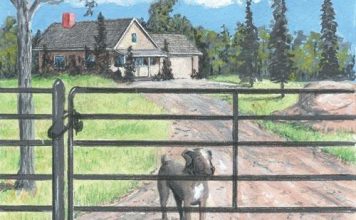 |
|
| Issue #27 • May/June, 1994 |
When I graduated from high school in 1960, my father wrote in my autograph book, “When you get married and have twins, don’t come to me for safety pins!” My role in our large family was Susie Homemaker, and sure enough, by age 21, I had fulfilled my destiny: two kids, two jobs, one husband. Later, to lighten the load, no husband.

Dorothy Ainsworth is shown holding the jig that helped her mark the birdsmouth notches on each rafter. The cupola frame rests atop the scaffolding behind her. |
For 15 years, I had put myself on the back burner. Hopes and dreams of security and independence had simmered. A notebook entitled “Wants and Needs in a Home” and a filing cabinet stuffed with log and timber-frame ideas revealed my yearning. An apartment-dwelling single mother waitressing in the big city was not my idea of the good life. Something in my genes insisted on a massive medieval fortress decorated in early pioneer. I wanted a house that the wolf himself couldn’t blow down!
I diligently shopped around for a nice small town, secured a job and apartment in advance, loaded up my kids, Eric and Cynthia (along with his piano and her horse), and we were off. Happiness was Reno, Nevada in my rear view mirror!
It took a year in idyllic Ashland, Oregon, to find a suitable piece of land I could afford and secure a farm loan, and another year to drill a well and “get electricity.” The third year I cut my baby (saw) teeth on remodeling a couple of old outbuildings into storage structures. Fraught with nothing but parallelograms, I learned harsh rule #1: “Plumb, Level and Almost Square” and tricky rule #2: “Measure Twice, Oops, Cut Twice.” That summer the hand tools used me.
The dog would slink away when I donned my carpenter’s belt and furrowed my brow in grim determination.

Raising the log walls |
For a novice, there’s no thrill like the tactile kinetic experience of driving a 16-penny nail home in three blows, then burying its head with two extra whacks for no reason. There was evidence of beginner’s overkill everywhere. Electrical cord repairs looked like snakes that had swallowed gophers. A job wasn’t finished until all the nails were gone. There were no gimmicks or shortcuts in the learning process. I sweated and strained and scarred. But the satisfaction of sawing a clean square cut with a hand saw rivaled sewing a fine seam or baking a perfect loaf of bread, and eventually the results became just as predictable.
It wasn’t long before I discovered power tools with my Sears charge card. Yikes, that could mean twice as many mistakes in half the time! My circular saw was a new force to be reckoned with. It came with two blades: ripper and shredder. When I braced myself with gritted teeth and squinted eyes, the dog scurried out of sight.

South view of the finished studio, showing the entryway, cushioned window seat and deck. The window seat looks out at a view of Mt. Ashland. |
Once in a while I’d take a break, sip a cup of coffee (liquid motivation) and gaze upon my 10 acres of star thistle and poison oak, envisioning a proverbial rose garden (without thorns) and a beautiful log home on top of the hill, surrounded by fruit trees in technicolor and kittens playing all around. For now, though, I’d enjoy the red-tailed hawk circling overhead and coyotes kiyiying at night. As a farmer creates his self-portrait in a freshly plowed field, I was driven to carve out an original relationship with this hilly, hostile chunk of land. There was no going back to the comfort zone.
I focused my energy and lucky things began to happen. Someone told me about lodge-pole pine logs available right out of the forest, for 3 cents a lineal foot. This economical option prompted some new possibility thinking. It confirmed my decision in favor of vertical-log construction for minimal notching and relative ease in handling and transporting. Inspired, I hastened down and bought a permit from the local ranger district of the U.S. Forest Service. I calculated gathering enough logs for one medium sized structure.

Setting one of the nine 12-foot-long foundation pilings. Each pressure treated piling rests on a poured concrete pad at the bottom of a 6-foot-deep hole. Each piling was set plumb with tamped shale and gravel. |
One day Eric was playing a Bach prelude; the next day his white knuckles were gripping a chainsaw and felling trees! After several excursions of terror and torture, we had stockpiled 180 logs for $42. Together we carried each 10″ eight-foot green log 100 feet or more, stepping over slash piles, hobbling, staggering, grunting and whimpering. As my grip weakened with every step, I kept mumbling to myself: “Only 3 cents a foot, only 3 cents a foot.” We loaded 15 at a time in the old Ford pickup and careened home, front-end floating.
Eric wanted an eight-sided piano studio (1000 sq. ft.) for good acoustics, and I wanted a barn-style house (1800 sq. ft.). The terrain dictated pier foundations. We decided to practice on the studio first. Flush-faced with enthusiasm, we sketched his “blue-print” on a napkin in a restaurant. Two heads are thicker than one, so we got a book from the library and set up the batter boards.
Upon one visit to the lumber yard, I spied a huge pile of large timbers in the back lot and my pulse quickened. It was love at first sight, and I bought them all as impulsively as a woman buys a pair of shoes. The salesman quietly wrote up my order for 10,000 board feet at $250/thousand (all my savings), looked up with one raised eyebrow and said, “Lady, do you know what you’re doing?” I said boldly, “No, but I know what I want.”

Dorothy wrestles a log out of her pickup. |
The stack included 30 huge pressure-treated pilings salvaged from an old railroad trestle. I just happened to need 29 pilings for both foundations!
About a week later, a neighbor stopped by, curious about my timbers, and revealed that he owned a boom truck and a giant auger bit. After a brief discussion of both foundation plans (my favorite subject), he offered to drill the holes and set the pilings for $10 each. I seized the opportunity at once, and began the grueling labor of cleaning out six-foot deep holes by day and “slinging hash” at the cafe at night.

The window seat adds a touch of beauty to the home. |
By this time I was acquiring some major muscle, and I needed every fiber. There was no shade. Crow’s feet turned into eagle’s claws, hands into lobster claws. I kept whispering to myself, “Only $290.00, only one week’s wages,” (for the piling holes). I once read that you get rich by spending yourself. I was filthy, sweaty rich. My sister said I was becoming the man I wanted to marry!
Soon after the piers were set, the backhoe man I hired to dig a waterline trench just happened to have a laser-beam transit in his hip pocket. He voluntarily marked all the piers level with each other. I cut them off and notched them to receive 4×12 rim joists for the piano studio and 6×12 girders for the house. I stood back and affectionately admired my big black pilings, spaced just so, jutting out of the stark landscape like Stonehenge. The time had come to contemplate the architectural overview of both structures and draw up the final plans, for county approval.
Logic told me to build within my capabilities, but aesthetics won out. “When ignorance is bliss, ’tis folly to be wise.” Hence the piano studio was to be an octagon converging into a square cupola, with triangles and trapezoids dancing heel and toe on the roof. I was like a spoiled child who wanted everything on my list, except there were no elves to help and no Santa to deliver. I wanted archways and bay windows, vaulted ceilings and skylights, wide window sills and a cushioned window seat for reading magazines and eating chocolates on a rainy day.

Using a chain saw as a chop saw for squaring off logs. The bolt and handle must be equal distance from the wall (very important). The tapered end of the log is shimmed to make the imaginary centerline of the log parallel with the level bench. |
But I would not employ a centerpost to support the roof! It would ruin the romantic notion of a nine-foot concert grand piano in the middle of the 30-foot room, with Chopin bouncing off the walls. The laws of physics have a way of humbling even the most deluded ego. I scratched my head while searching my memory banks. Eureka! I remembered the “yurt principle.” A hidden cable would defy gravity.
Yes, I wanted it all, completed in this lifetime, on a shoestring. Time and energy are the basic currencies of life; lack of money is merely an inconvenience. A sense of urgency gripped me.
What started out as “we” ended up as “me.” Eric and Cynthia went off to college and met mates. Nature had its way. Meanwhile, back at the ranch, I was fluttering about creating a nest so there’d be something to be empty. Someday the chickens might come home to roost. I imagined future music festivals: spontaneous gatherings of diverse and harmonious spirits, and rosy-cheeked grandkids giggling and dancing about the room. Goals are dreams with a deadline, so I grabbed my hammer and got busy.

“Flatting” a log to create a flat, even side. Here, Dorothy is making one of many shallow kerf cuts down to snapped chalk lines. Later she cut off the pieces formed by these cuts to create the flat side. |
Building the floor was laborious but uncomplicated. Joists and subflooring were secured with screws–no creaking allowed. When I needed to “rest,” I’d peel logs with my trusty drawknife. I documented all progress with self-portraits. Photography is my hobby.
The library was usually my best friend, but when it came time to square off the logs, there was no book. With the optical illusions involved in staring at a gnarly tapered log, it’s impossible to eyeball the cut. One can end up with a pile of firewood. After trial and error (and a little kindling), I devised a contraption using my chainsaw as a chop-saw and it worked beautifully!
Erecting the vertical-log walls kept me as busy as a Beethoven sonata. The general procedure was “Cut ’em off, stand ’em up, spike ’em in.” Pre-drill like a drill sergeant. To get from here to there, hug a log real tight and waddle with it. Who cares what the neighbors think? One sunny afternoon two bicyclists rode by and one yelled, “Hey look, they put the logs the wrong way!”

Drilling the holes for the steel cables. The hole locations were carefully measured so that the cable makes a perfect circle centered on the axis of the building. This precision ensures an even distribution of tension on all the rafters. |
When the walls were standing and the headers in their final resting places, it was time to place the square cupola aloft. A gin pole put it there and scaffolding held it fast. Cutting the confounded compounded angles where three rafters met at the corners required some finesse with the 12″ electric chainsaw. Next, to really challenge my capabilities, each birdsmouth had to be individually measured with a template and custom cut. After transferring the measurements to a 16′ 2×12 rafter on the floor and making all the cuts, I pushed it up a long ladder propped against the scaffolding, one step at a time. Then I pivoted it on the top railing, using leverage to lower it slowly down onto its mark on the top plate, and fastened it to the cupola. When the birdsmouth miraculously seated in place, I sighed, “Ahhh, life doesn’t get any better than this.” The word “birdsmouth” still evokes a spiritual feeling in me.
The hardest job of all was going from the delicious solitude of the country to work at the cafe, where trying to get a bite to eat in 8 hours was like a giraffe at a watering hole with the lions coming. At home I had the freedom of a monkey, climbing up and down the rungs of the scaffolding. My goal was two rafters a day, 60 in all. I’d work right up to the last minute, then put on my war paint, fire up old Bessie, and speed to work, curling my eyelashes with one hand and steering with the other. I lost a few eyelashes that summer.

Partial view of the finished studio. Note the open vaulted ceiling. |
I glued and screwed every rafter, then drilled holes in their tails (just above the top plate) to receive the cable and four turnbuckles. I bushed each hole with annealed nylon. The moment of truth came with tightening the turnbuckles and removing the scaffolding. Nothing creaked, croaked, or settled. The structural integrity of my design was uncompromised!
Eight of the main rafters, like spokes, are true 2×12’s, the rest 2×10’s, to provide a 2″ recessed nailing surface for the lx12 pine ceiling. With age, pine mellows to a warm and wonderful patina. I helped it along with a coat of semi-gloss lacquer.
Now and again people would happen by offering advice–armchair experts. I never had to ask for a second opinion; dozens came, unsolicited. I discovered that common sense is not so common. Gullible ears will be filled. After pursuing a few wild geese, I became a skeptical inquirer. “Why don’t you just….,” was the quickest phrase to make me surreptitiously roll my eyes at the dog and feign snoring, then try to get back to work. In all my brief encounters, I never met a man who hadn’t once lived in a teepee and built a log house–a curious phenomenon indeed.

This is the steel cable that keeps the weight of the roof over the uprights by preventing the rafter ends from spreading outward. This cable eliminates the need for a centerpost and allows an open, vaulted ceiling. |
An old friend taught me how to use clamps as a “poor-man’s assistant.” With auxiliary “hands,” the roof plywood went on fast. I topped it off with shingles just before the first rainfall of autumn. I furred out the inner walls with 2×4’s, hid the wiring and insulation, and covered it all up with sheetrock. With the garden sprayer, everything on the outside got a dose of the old boatbuilder’s recipe (linseed oil, marine varnish, and turpentine) whether it needed it or not. The overspray restyled my hair!
I chinked the logs with 1½” foam pipe insulation, sanded and painted brown, then glued in place. I caulked with 50-year silicone seal (dark brown) and smoothed out each bead manually. For one month I was the self-appointed “Caulking Queen of Ashland,” as evidenced by the splayed out middle finger of my right hand.
Since the walls were a foot thick, I made the window framing to accommodate. I used 1½ boards (one whole and one ripped in half) of pine 2×10’s splined together, screwed and plugged in place. I ordered double-paned glass to fit each opening and secured the windows with my own molding. Simple brass casement adjusters open some of the smaller windows for cross ventilation. Built-in sliding windows in the cupola and a ceiling fan whisk out hot air.

The entryway. |
Spatial relationships reign in the palisaded palace. Windows in clusters of threes, and tile work in the entryway, hearth, and bay window, repeat themes for visual appeal. To me, archways are the crowning glory in a home, perhaps hearkening back to my ancestry in a cave. I built them out of 2×10 “splined-pine,” by cutting the curves on my band saw, then laminating to the right thickness.
I glued and screwed and clamped, butcher-block style, and sanded the attractive end-grain until smooth. The stout arches lend support in spanning the doorways. I covered the 1″ subfloor with 3/4″ particle board and cozied it all over with carpet.
I tallied my expenditures. The cost of the piano studio came to $15,000, the sum total of “tips” I earned and spent daily. I was debt-free.
Three years had whizzed by and I was putting the finishing touches on my “baby.” I sat down on the deck to rub sawdust out of my bloodshot eyes and pet the dog, when Eric appeared like an apparition! After piano-tuning school and a three-month hike on the Pacific Crest Trail to “round out his education,” he came back to visit mom and his piano. I cleared the sawdust out of my ears and asked him to play. When I heard beautiful Mozartian trills wafting out the Dutch door and across the sunlit hills, it was all worthwhile…a labor of love.
Eric is now a tuner, teacher, performer and composer in Ashland. Cynthia is a model, actress, and photographer in San Francisco (and she still loves horses).

Dorothy hanging from the rafters. |
Having served my apprenticeship, I was ready to get started on the main house. New dreams beckoned. As serendipity would have it, I met a huge and handsome hunk (Kurt) at the fitness center and he whispered the magic words in my ear, “Let’s go get your logs.” We did, 300 of them, for $72. This time I was in love and feeling no pain. We laughed and giggled and sighed while laboring through the summer. When I couldn’t lift my end, Paul Bunyan carried the whole 300 lb. log on his shoulder! I swooned and snapped photographs.
The winter of 1991 I built a model of the house to manifest the joinery inherent in my design: mortise and tenon joints, connecting girts and knee braces (all out of logs). I would use the timbers as ridge beams, top plates and cantilevered deck supports.
Kurt was not a carpenter; he had his own career. I wanted to tackle this new project myself, so we agreed he would help me with the logistics of raising the frame and any task impossible to do solo. He comes running only when he hears a blood-curdling scream.

The basic timber-and-log frame of the main house, now under construction. Dorothy has promised to write us a future article on this project. |
The first year of actual construction (1992) was spent building the floor and peeling logs; this second year (1993) the frame and roof. The pay as-I-go method (estimated from the piano studio) will ultimately cost $15/sq. ft. ($27,000). Though I pause to write, I’m in the process of roofing with barn-red metal, trying to beat the fall rains again.
When I purchased 2200 square feet of steel panels, 4000 screws and all the trimmings, the salesman commented, “This is definitely a two-man job.” I thought….gulp…., “How about one woman?” It’s been a little scary, flirting with the undertaker on a 6-in-12 pitch, 18′ up, but affordable. This winter, as the rain patters down, christening the new roof, I’ll be working inside with a Mona-Lisa smile on my lips, so glad to be on level ground again!
I still blow-dry my hair on the way to work with the windows down, but I have a brand new bumper sticker: Caution, Driver Applying Makeup.
Read about how Dorothy recovered from a devastating fire
in the March/April 1996 issue of BHM.
Learn more about Dorothy and/or contact her at her website www.dorothyainsworth.com















